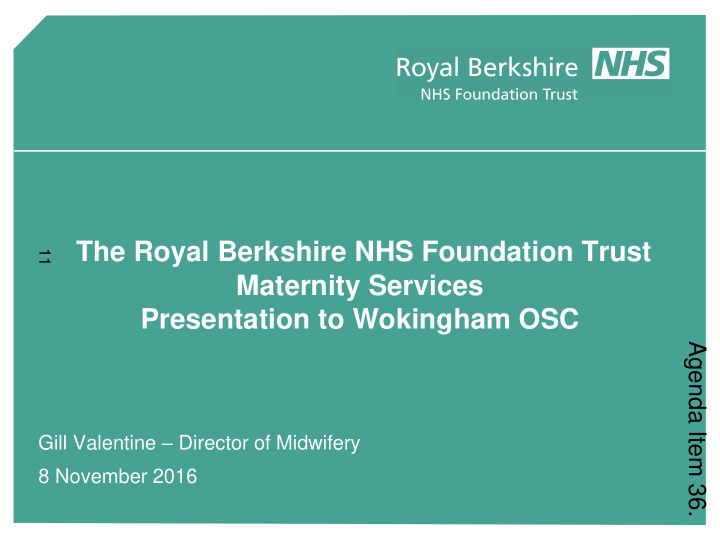



The Royal Berkshire NHS Foundation Trust 11 Maternity Services Presentation to Wokingham OSC Agenda Item 36. Gill Valentine – Director of Midwifery 8 November 2016
Maternity services for Wokingham Maternity services provided for the population of Wokingham: • Community midwifery services – antenatal care, homebirth, postnatal care 12 • Hospital based antenatal care – outpatient (including satellite consultant clinics in Wokingham Hospital) and in patient antenatal care • Intrapartum care – Rushey midwifery led unit, Consultant led delivery suite • Hospital postnatal care 2
Maternity Activity 2015/16 2016/17 year to date 13 Deliveries 5493 2753 (5505) Births 5596
Staffing • Current establishment 187 WTE midwives • This would provide a midwife to birth ratio of 1:29 • Other local providers of maternity services have ratios 1:30 – 1:35 14 • Throughout 2015/16 actual ratio at RBFT has ranged from 1:32 to 1:34 (fluctuation month on month caused by number of births and staff in post ). However month on month we have achieved 98% -100% of women having 1:1 care in labour • 39% of the midwifery workforce are within the 45-65 age bracket with 27% being over 50 years of age. This is an equivalent profile with the rest of Thames Valley.
Staffing continued • Skill mix review – nurses, maternity support workers • Recruitment – monthly assessment centres, recruitment 15 fair Dublin • Reading Nursing and Maternity Recruitment Day 12 November • Agency midwives • Development opportunities for staff as part of programme for succession planning 5
Maternity Unit Diversions • Reciprocal arrangements are in place with neighbouring maternity services providers: for example, we accept women from other hospitals’ units when they require assistance and they accept our women when we require assistance • Unit diversion only implemented when all other escalation has been implemented 16 • Maternity units divert when they are at full capacity or if they do not have sufficient staffing for the workload • Between May and October 2015 the diversion rate was 4.8 per calendar month affecting on average 10 women per month. Between January and September 2016 the diversion rate was 3.5 per calendar month with 3.6 women affected per month
CQC report into Maternity 17 Services November 2015 7
CQC Report • Feedback from women about their care and treatment was consistently positive • Women were involved with their care and had their wishes respected and understood • All clinical areas were appropriately equipped to provide safe care and were visibly clean 18 • The normal delivery rate was comparable with the England average and the unassisted delivery rate was good when compared with the England average. Caesarean section rates were similar to the England average: however instrumental delivery rates were slightly higher than the England average • When people received care from a range of different staff, teams or services, this was coordinated and staff worked collaboratively 8
Staffing • Consultant presence on delivery suite remained below the recommended level of 168 hours per week • The Trust goal was to have midwife to birth ratio in line with Birthrate Plus of 1:29 by April 2017 and a 1:30 ratio in 19 2015-16 • Number of maternity unit diversions indicated that the service was not able to be responsive. 9
CQC Report Action plan update: • Four new consultant obstetricians/gynaecologists have been employed which has increased the consultant cover to 116 hours per week. 20 • Further consultants to be appointed in 2017 with the intention of achieving 168 hour cover • Midwifery recruitment plans detailed in previous slide • Number of unit diversions has reduced 10
National Maternity Review 2016: Better Births • This report set out a vision for maternity services across England, which is • for services to become safer, more personalised, kinder, professional and more family friendly 21 • for all staff to be supported to deliver care which is women centred, working in high performing teams, in organisations which are well led and in cultures which promote innovation, continuous learning and break down organisational and professional boundaries 11
National Maternity Review 2016: Better Births • The three priorities for RBFT in 2016/17: • Personalised care (women should be able to make decisions about the support they need during birth and where they would prefer to give birth whether this is at home, in a midwifery led unit or in an obstetric unit) 22 • Continuity of carer (every women should have a midwife, who is part of a small team of 4-6 midwives based in the community who knows the woman and family and can provide continuity of care. Each team of midwives should have an identified obstetrician) • Better postnatal care and perinatal mental health 12
23 Thank you. Any Questions?
This page is intentionally left blank
Recommend
More recommend